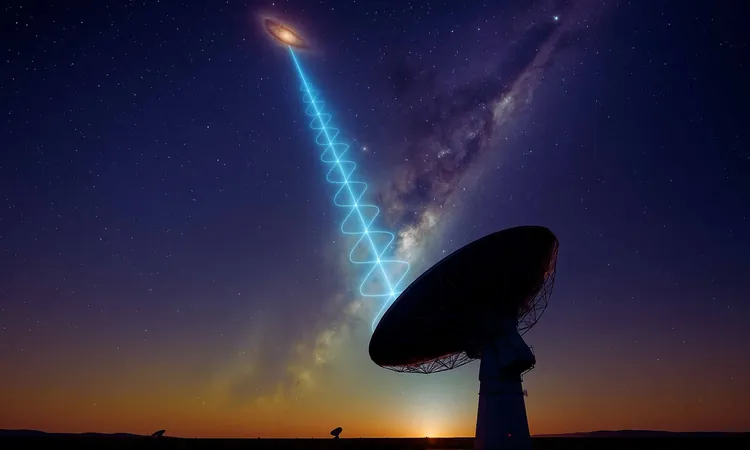
Mysterious Deep Space Radio Bursts Hit Earth in an Extraordinary Blitz
2025-08-25
Author: Yu
A Cosmic Phenomenon Unraveled
In an astonishing discovery, a team of astronomers using the MeerKAT radio telescope in South Africa has identified a new source of fast radio bursts (FRBs), unleashing a barrage of sharp radio pulses that have struck Earth hundreds of times in just minutes. This unprecedented outburst offers a tantalizing glimpse into the mysteries of the universe.
What Are Fast Radio Bursts?
Fast radio bursts are brief but intense bursts of radio energy that last mere milliseconds and emanate from galaxies far beyond our own. They provide researchers with unique opportunities to study matter scattered throughout the cosmos, revealing the complex structures and dynamics of the universe.
Capturing the Cosmic Storm
Led by Jun Tian from the Jodrell Bank Centre for Astrophysics at The University of Manchester, the MeerTRAP project successfully detected FRB 20240619D on June 19, 2024, capturing three bursts within just two minutes. A week later, a follow-up observation recorded a staggering total of 249 bursts across various frequency bands, making it one of the most prolific sources of FRBs ever documented.
Decoding the Bursts' Signatures
Analysis revealed a striking frequency pattern, with most activity focused on the L band. The bursts exhibited distinct substructures, with some showing a downward frequency drift—a common trait among repeating FRBs. These features suggest compact emission zones and rapid variability, challenging existing theories about how these bursts are generated.
Polarization: The Key to Understanding
The polarization data unveiled another layer of complexity. Most bursts displayed nearly complete linear polarization while a significant portion exhibited measurable circular polarization. This combination narrows down the potential physical models for the bursts' origins, hinting that they may be produced in or near the magnetic fields of magnetars instead of distant shock waves.
No Optical Counterpart Found
In tandem with the radio observations, astronomers monitored optical signals with the MeerLICHT telescope but uncovered no corresponding optical flash linked to the bursts. This finding eliminates the possibility of bright optical companions contributing to the radio signals, further deepening the mystery surrounding FRB 20240619D.
Understanding Repeating FRBs
The active nature of FRB 20240619D reignites questions about the origins of repeating versus non-repeating FRBs. With this new data, researchers can explore whether these events come from similar sources or reflect distinct astrophysical phenomena. Notably, prior repeaters such as FRB 20121102A have exhibited comparable burst storms, suggesting underlying commonalities.
The Importance of These Findings
This dramatic influx of radio bursts allows scientists to test various astrophysical theories, measure essential cosmic parameters, and improve our understanding of the hidden structures of the universe. As FRBs traverse intergalactic space, they illuminate invisible ionized gas, helping researchers map the vast cosmic web.
Final Thoughts
These findings will be published in the Monthly Notices of the Royal Astronomical Society, marking a significant step forward in our quest to demystify the enigmatic signals from deep space and their potential implications for our understanding of the universe.



 Brasil (PT)
Brasil (PT)
 Canada (EN)
Canada (EN)
 Chile (ES)
Chile (ES)
 Česko (CS)
Česko (CS)
 대한민국 (KO)
대한민국 (KO)
 España (ES)
España (ES)
 France (FR)
France (FR)
 Hong Kong (EN)
Hong Kong (EN)
 Italia (IT)
Italia (IT)
 日本 (JA)
日本 (JA)
 Magyarország (HU)
Magyarország (HU)
 Norge (NO)
Norge (NO)
 Polska (PL)
Polska (PL)
 Schweiz (DE)
Schweiz (DE)
 Singapore (EN)
Singapore (EN)
 Sverige (SV)
Sverige (SV)
 Suomi (FI)
Suomi (FI)
 Türkiye (TR)
Türkiye (TR)
 الإمارات العربية المتحدة (AR)
الإمارات العربية المتحدة (AR)